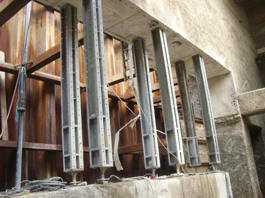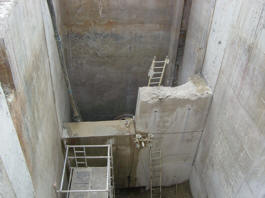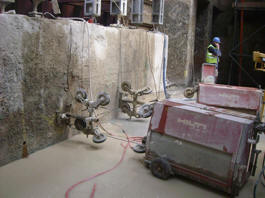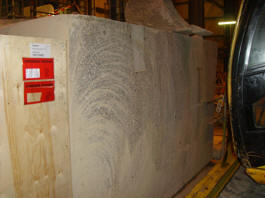|
|
Diamond wire sawing provides the power First published - INDUSTRIAL DIAMOND REVIEW 1/08 |
|
HOME PAGE |
Marchwood Power Limited was set up as the project company to construct the 850 megawatt combined cycle gas turbine (CCGT) power station. The facility is being built under a turnkey Engineering Procurement Construction contract by a consortium of Siemens pic and Siemens AG. Construction started early in 2007 and commercial operation is scheduled for 2009. The plant is located on the site of the former power station in the Marchwood Industrial Park. This location was selected primarily because of its previous use as a power station, offering efficient re-use of brownfield land rather than development of a greenfield site.
Another key factor in choosing Marchwood was that it was possible
to utilise much of the existing infrastructure from the previous
power station. A significant example of this is utilising the
existing heavily reinforced concrete basement structure that
housed the old plant and machinery. Obviously, the interior
layout of this basement would have to be amended to suit the new
design, and Trant Construction Ltd, the appointed subcontractor
for the civil engineering works, decided to use diamond wire
sawing to remove unwanted sections of wall. Hampshire Chasing Ltd, based nearby was selected to carry out the wire sawing, which involved the removal of 1,441 tonnes of heavily reinforced concrete, arguably the biggest contract of its kind in the UK. With a large cutting operation such as this, Hampshire Chasing's MD, Steve Sorrell took personal control of the job. The close proximity of the company's headquarters to Marchwood guaranteed a quick response time to any request from Trant and was a key factor in the work being carried out successfully. Inner chamber walls were 770 mm thick and up to 12 m high, whereas the outer sea wall was between 1.2 - 2.4 m thick, up to 4.85 m high and 15 m in length. In addition, this sea wall had 20 mm thick steel sheet piling which acted as a coffer dam. The reinforcement bars were a maximum of 32 mm in diameter and spaced as closely as 150 mm c/c. Years ago, all of the old basement chambers had been backfilled up to surface level and this surplus material had to be removed. Rather than excavate it all at once, it was agreed between Trant and Hampshire Chasing that this removal would be carried out sequentially in depths of less than 2 m which would enable the wire sawing to be undertaken without the need for expensive and time consuming erection of scaffolding. This meant, however, that Hampshire Chasing had to liaise closely with Trant to ensure that the wire sawing was completed within the minimum of time as the excavation proceeded. Hampshire Chasing had two teams of men on standby ready to move in at short notice, often working a 12 hour shift if necessary. The work had to be carried out in the winter months in the most arduous of conditions and often in very restricted working spaces. All Hampshire Chasing's operatives had to have the necessary Health & Safety qualifications to do this. Two diamond wire saws were employed on the job, one for each team. These were supplied by Hilti UK and the diamond coring bits used to create holes for wire insertion were from Crewcut Ltd. Work commenced in July 2007 and was completed on time in January 2008.
The core holes needed for wire insertion were drilled in a time of around 30 minutes for a typical 770 mm thick wall. The length of wire used was 15 m, which achieved an average cutting rate of 0.75 m2/hr. Wire life averaged out at around 1.5 m2/mofwire. Concrete sections were cut into roughly 12-15 tonne blocks and lifted away for breaking down and removal from the site. Thanks to a good working relationship between Trant and Hampshire Chasing, notice, often working a 12 hour shift if necessary. The work had to be carried out in the winter months in the most arduous of conditions and often in very restricted working spaces. All Hampshire Chasing's operatives had to have the necessary Health & Safety qualifications to do this. Two diamond wire saws were employed on the job, one for each team. These were supplied by Hilti UK and the diamond coring bits used to create holes for wire insertion were from Crewcut Ltd. Work commenced in July 2007 and was completed on time in January 2008. The wire saws were Hilti model WS 15 and the diamond wire was Hilti's LC brand, which has 10.5 mm diameter diamond beads spaced at 40 beads/m. The drill bits employed were Crewcut type CCD3, which, like the Hilti diamond wire were specially developed for cutting through heavily reinforced concrete such as that encountered here. Typically, a team would saw up to 6 m2 in a day and the total cut area for the whole job was just over 650 m2. The core holes needed for wire insertion were drilled in a time of around 30 minutes for a typical 770 mm thick wall. The length of wire used was 15 m, which achieved an average cutting rate of 0.75 m2/hr. Wire life averaged out at around 1.5 m2/mofwire. Concrete sections were cut into roughly 12-15 tonne blocks and lifted away for breaking down and removal from the site.
This new development at Marchwood is a good example of the type of modern facilities being developed by UK power companies, which represent advanced generating technology in terms of high operating efficiencies and low emissions. When it comes on stream, Marchwood Power will operate at around 58% fuel efficiency, compared to the 30%-35% efficiencies achieved in the previous power station. In terms of diamond cutting technology too, this project at Marchwood demonstrates the latest in the state-of-the-art. Fifteen years or so ago, cutting through concrete walls of this thickness could only have been carried out by stitch drilling, a time consuming process which also involved much making good of the concrete surface left behind. The introduction of diamond wire sawing into concrete cutting has enabled jobs such as this to be carried out much more quickly and precisely, and, perhaps more importantly, more economically. In theory, there is no limit to the thickness of concrete that can be cut, since the diamond wire sawing technique was originally developed for the stone industry where diamond wire lengths of up to 100 m are not uncommon. <*>
Contacts |
Copyright © 2009 Hampshire Chasing Ltd. - All Rights Reserved.
 In
the middle of 2006, ESB International (ESBI) announced an
agreement with Scottish & Southern Energy to build a major new
In
the middle of 2006, ESB International (ESBI) announced an
agreement with Scottish & Southern Energy to build a major new

 The
wire saws were Hilti model WS 15 and the diamond wire was
Hilti's LC brand, which has 10.5 mm diameter diamond beads
spaced at 40 beads/m. The drill bits employed were Crewcut type
CCD3, which, like the Hilti diamond wire were specially
developed for cutting through heavily reinforced concrete such
as that encountered here. Typically, a team would saw up to 6 m2
in a day and the total cut area for the whole job was just over
650 m2.
The
wire saws were Hilti model WS 15 and the diamond wire was
Hilti's LC brand, which has 10.5 mm diameter diamond beads
spaced at 40 beads/m. The drill bits employed were Crewcut type
CCD3, which, like the Hilti diamond wire were specially
developed for cutting through heavily reinforced concrete such
as that encountered here. Typically, a team would saw up to 6 m2
in a day and the total cut area for the whole job was just over
650 m2. Thanks
to a good working relationship between Trant and Hampshire
Chasing,
Thanks
to a good working relationship between Trant and Hampshire
Chasing,